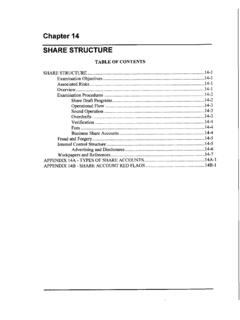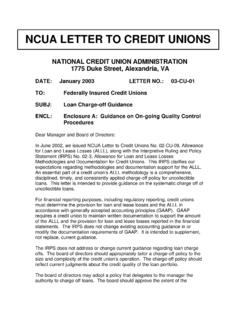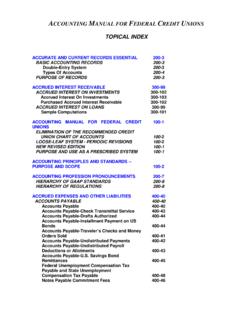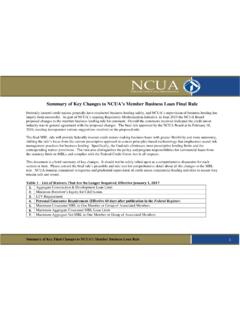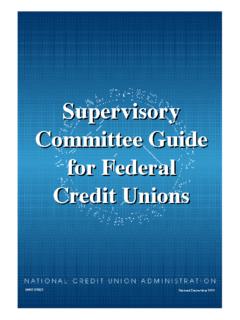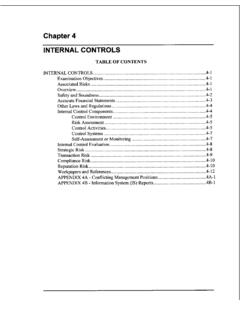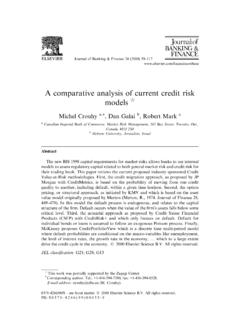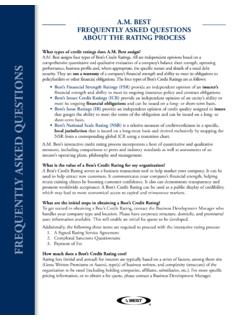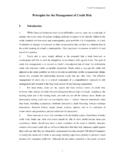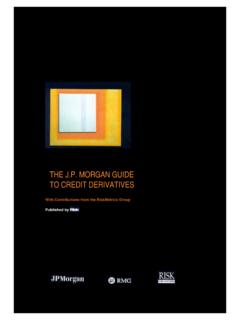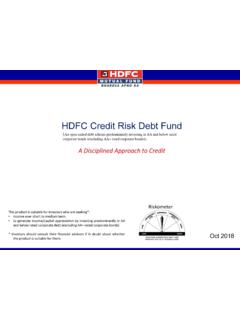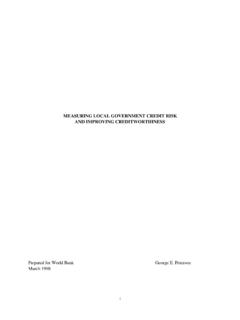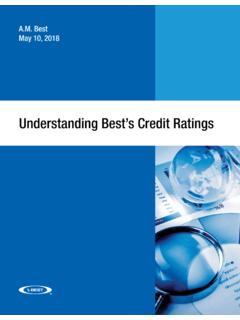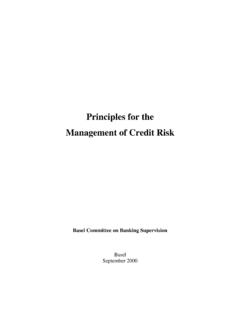Transcription of Evaluating Compliance Risk - Updated Compliance Risk ...
1 _____ Supervisory letters are official agency examination policy. These letters communicate guidance to NCUA field staff on regulations and exam procedures. Each supervisory letter focuses on a specific topic, providing background information and outlining any related regulatory and statutory requirements. Supervisory letters may also require field staff to perform certain procedures during an examination; in these cases, the letter will provide instructions to help field staff implement the procedures. Supervisory letters are intended to provide a framework for more consistent application of staff judgment with respect to conclusions about a credit union s financial and operational condition, and related CAMEL and risk ratings . These letters also provide a consistent approach for Evaluating the adequacy of a credit union s relevant risk-management processes. Supervisory criteria detailed in a supervisory letter are not strict requirements, unless noted as required by law or regulation.
2 The supervisory criteria contained in these letters are used by field staff to evaluate a credit union s condition based on the preponderance of relevant factors. Generally, supervisory letters are shared with the public as an attachment to a Letter to Credit Unions. Supervisory Letter NCUA | Office of Examination & Insurance SL No. 17-01 1775 Duke Street, Alexandria, VA 22314 March 29, 2017 TO: All Field Staff SUBJECT: Evaluating Compliance Risk Updated Compliance Risk Indicators ENCL: Updated Compliance Risk Indicators AIRES Compliance Risk Questionnaire This supervisory letter provides an Updated list of Compliance Risk Indicators (see Appendix A) that are a part of NCUA s Risk-Focused Examination program. Also enclosed is the Updated AIRES questionnaire for Compliance The guidance in this document applies whenever field staff evaluates Compliance risk in a federally insured credit union. Field staff will begin using the Updated list of Compliance Risk Indicators for any supervisory evaluations of Compliance Risk started on or after March 31, The Updated list of Compliance Risk Indicators builds upon the current set of indicators and provides additional guidance for field staff in assigning the Compliance risk rating one of the existing seven risk categories in the Risk-Focused Examination program.
3 The update reflects transformations in technology, business models, and members banking habits since the list of Compliance Risk Indicators were originally developed in 2002. The update results in a more comprehensive, integrated and transparent framework in Evaluating a credit union s ability to manage its risk of violations and non- Compliance with applicable laws and regulations. 1 The questionnaire will be incorporated into AIRES by June of 2017. 2 March 31, 2017, is also the effective date for the revised Federal Financial Institutions Examination Council (FFIEC) Uniform Interagency Consumer Compliance Rating System. NCUA, as an FFIEC member agency, has incorporated the principles of the revised Consumer Compliance Rating System into the Compliance Risk Indicators. The supervisory evaluation of Compliance is ordinarily conducted as part of NCUA s risk-focused examinations of credit unions, not as a separate examination.
4 NCUA Supervisory Letter No. 17-01 March 2017 Risk-Focused Examinations and Compliance Risk 2 The Updated list of Compliance Risk Indicators does not create a new Compliance rating, does not separate consumer Compliance from overall Compliance , and does not i mpose any new or higher supervisory expectations for credit unions. Exam Procedures NCUA s assessment of Compliance risk encompasses all of the federal consumer financial protection laws and regulations NCUA enforces, as well as other relevant laws and regulations that govern the operation of credit unions, such as the Bank Secrecy Act, the Flood Disaster Protection Act, and the SAFE Act. Field staff will continue to reflect their conclusion about a credit union s Compliance risk, and management of that risk, in the Compliance risk rating,3 the Management CAMEL component rating, and the CAMEL composite rating as NCUA s approach to examining a credit union s Compliance with applicable laws and regulations remains risk-focused with appropriate consideration given to a credit union s size, complexity, and risk profile.
5 Field staff will draw on their professional judgment to target their efforts to the areas of greatest existing and potential risk. Field staff s supervisory evaluation will typically focus primarily on Evaluating the sufficiency of a credit union s overall approach to managing Compliance risk also referred to as a Compliance management system. As reflected in the Updated Indicators, Compliance risk is best managed by an institution when its Compliance management systems are proactive; that is, they promote self-identification and self-correction of any identified Compliance deficiencies. Field staff s evaluation will also routinely include specific and/or in-depth reviews of some areas of special emphasis based on statutory requirements,5 changes to laws or regulations, broad trends, or institution specific risk The supervisory evaluation of Compliance need not, and typically does not, include specific or in-depth evaluations of Compliance with all applicable laws and regulations or extensive transaction testing.
6 The Updated framework incorporates and adds detail to the current Compliance Risk Indicators to aid field staff in Evaluating Compliance risk. The Updated Compliance Risk Indicators framework has three broad categories: Board and Management Oversight; Compliance Programs; and Violations of Law and Consumer Harm. Each category has several factors, (briefly summarized below). Field staff will assess the first two with consideration given to a credit union s size, complexity, and risk profile. In particular, field staff will consider: 1. Board and Management Oversight o Commitment to the credit union s Compliance management system. 3 NCUA s Letter to Federal Credit Unions 02-FCU-09, Risk-Focused Examination Program discusses the seven categories of risk, including Compliance risk, that comprise a credit union s risk profile. Based on field staff s evaluation of the risk, each risk category is assigned a risk level of low, moderate, or high.
7 4 See NCUA Letter to Credit Unions 07-CU-12 regarding the CAMEL rating system. 5 For example, NCUA is required by law to review Compliance with the Bank Secrecy Act and the Flood Disaster Protection Act at all examinations of insured credit unions. 6 Field staff should continue to refer to the annual Exam Scope instruction for requirements for each type of federally insured credit union examination. NCUA Supervisory Letter No. 17-01 March 2017 Risk-Focused Examinations and Compliance Risk 3 o Effectiveness of change management processes. o Risk management associated with products, services, and activities. o Self-identification efforts and corrective actions taken. 2. Compliance Program o The effectiveness of a credit union s Compliance management system. o Policies and procedures, training, monitoring and audit programs, and complaint resolution. 3. Violations of Law and Consumer Harm (if applicable) o Pervasiveness of the violation. o Root cause of the violation.
8 O Severity of the violation or any consumer harm. o Duration of the violation. In assigning a Compliance Risk rating, field staff consider the totality of the Compliance Risk Indicators. Any single or small subset of Compliance Risk Indicators i s not necessarily determinative of the existence of lower or higher risk. An effective risk assessment is a composite of multiple factors. Depending upon the circumstances, certain factors - such as the quality of the credit union s overall approach to Compliance management, or the existence of pervasive or severe violations - may be weighted more heavily than others. See Appendix A for the full chart of Compliance Risk Indicators. If you have any questions on the material in this letter, please direct them to your immediate supervisor or regional management. Sincerely, /s/ Larry Fazio Director Office of Examination & Insurance NCUA Supervisory Letter No. 17-01 March 2017 Risk-Focused Examination and Compliance Risk: Appendix A 1 Appendix A: Compliance Risk Indicators Factor Low Moderate High Board and Management Oversight Board and management oversight factors should be evaluated commensurate with the credit union s size, complexity, and risk profile.
9 Compliance expectations below extend to third-party relationships. Oversight and Commitment Board and management fully understand all aspects of Compliance risk and exhibit a clear commitment to Compliance . Commitment is communicated throughout the credit union. Board and management demonstrate strong commitment and oversight to the credit union s Compliance management system. Significant Compliance resources are provided, including systems, capital, and human resources. Staff is knowledgeable, empowered and held accountable for Compliance with consumer laws and regulations. Management conducts comprehensive and ongoing due diligence and oversight of third parties consistent with NCUA expectations to ensure that the credit union complies with consumer protection laws and regulations. Where appropriate, the credit union exercises strong oversight of third parties policies, procedures, internal controls and training to ensure consistent oversight of Compliance responsibilities.
10 Board and management reasonably understand the key aspects of Compliance risk. Commitment to Compliance is reasonable and satisfactorily communicated. Board and management provide satisfactory oversight of the credit union s Compliance management system. Compliance resources are adequate and staff is generally able to ensure the credit union is in Compliance with consumer laws and regulations. Management conducts adequate and ongoing due diligence and oversight of third parties to ensure that the credit union complies with consumer protection laws and regulations. They adequately oversee third parties policies, procedures, and internal controls, and training to ensure appropriate oversight of Compliance responsibilities. Board and management does not understand, or has chosen to ignore key aspects of Compliance risk. The importance of Compliance is not emphasized or communicated throughout the organization. Management has not established or enforced accountability for Compliance performance.

